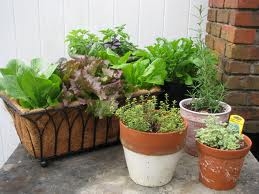
A wheelbarrow that has corroded past its useful life can be pierced with drainage holes, lined with moss, filled with soil and planted in leafy, lime-green ‘Tom Thumb’ lettuces. Underplanted with white and purple scallions and crunchy round ‘Planet’ carrots, these lettuces can provide the makings of salad just outside your kitchen door.
No room for a wheelbarrow or wine barrel? Even a standard 15-inch pot can host six mature heads of red romaine lettuce and a handful of radishes, or two dozen leeks, or a bouquet of ‘Bright Lights’ Swiss chard with its ruby-red, yellow and deep orange stalks and vitamin-rich greens.
‘Pixie’ cabbages, ‘Tom Thumb’ lettuces, ‘Green Fingers’ eggplants and ‘Baby Primor’ leeks are just a few of the diminutive vegetables bred for those spots that you thought were too small for a garden.
Changing demographics, aging gardeners and shrinking yards have prompted seed breeders to develop smaller versions of garden favorites with all the big flavors of their larger cousins.
Labels on vegetable seedlings often indicate whether the variety will thrive in containers, but starting vegetables from seed gives you more opportunity. Don’t hesitate to mix flowers and vegetables in container plantings. Petunias discourage pests that attack pole beans, and marigolds reputedly protect tomatoes. In containers with vegetables, they perform the same duties, while adding interest and color.
Container gardens are more dependent on the gardener than in-ground garden plots. Although a few vegetables can take deep shade, most need at least six hours of sun a day to produce abundant crops.
Pots and boxes dry out more quickly than garden plots and on warm or windy days may need to be watered twice. Please remember to run the hot water out of your hose before you begin watering. Hot water can kill plants, and too much warmth in the root zone can cause salad greens, cilantro, spinach and other cole crops and greens to bolt.
Watering a container as often as needed to keep the plant hydrated can deplete soil nutrients quickly. Nutrients leach out with the water each day. Slowed growth or yellowed leaves are signs that your plants may have used all the soil nutrients. Frequent light feeding with fish emulsion or other suitable fertilizers will keep your plants healthy, green and growing. Follow package directions. Too much fertilizer can build up salt in your soil. If you notice a light salt coating on your pots, wash the pots and cut back on fertilizing.
Size does matter. Make sure your containers are large enough to provide ample room for the plants’ mature root systems.
Putting large containers on casters allows you to wheel them around to take advantage of sunlight and to protect them from too much sun or frost. You can cluster pots or move them into the shade to slow evaporation.
With plants on wheels, you can “decorate” your patio or porch more easily. Showcase the natural beauty of blossoming or heavily-laden plants and wheel past-their-prime specimens to a less conspicuous spot.
With a small container garden on your patio or deck, you can really get to know your plants. Their proximity makes it easy to groom them daily, monitor their moisture needs and catch problems and insect attacks more quickly.
There is something wonderful about watching plants grow, but to pluck your dinner from the comfort of your deck or balcony might just be the best reward a gardener can hope for.
Container Gardening Workshop: Napa County Master Gardeners will conduct a workshop on “Container Gardening” on Saturday, May 18, from 9:30 a.m. to 11:30 a.m., at the University of California Cooperative Extension office (address below). Learn to grow mobile gardens that take advantage of the best sites in your yard or home. Discover the best containers, soils and locations for your plants to prosper. Online registration (credit card only) Mail in registration (cash or check only)
Master Gardeners are volunteers who help the University of California reach the gardening public with home gardening information. Napa County Master Gardeners (http://ucanr.org/ucmgnapa) are available to answer gardening questions in person or by phone, Monday, Wednesday and Friday, 9 a.m. to Noon, at the U. C. Cooperative Extension office, 1710 Soscol Avenue, Suite 4, Napa, 707-253-4143, or from outside City of Napa toll-free at 877-279-3065. Or e-mail your garden questions by following the guidelines on our web site. Click on Napa, then on Have Garden Questions?